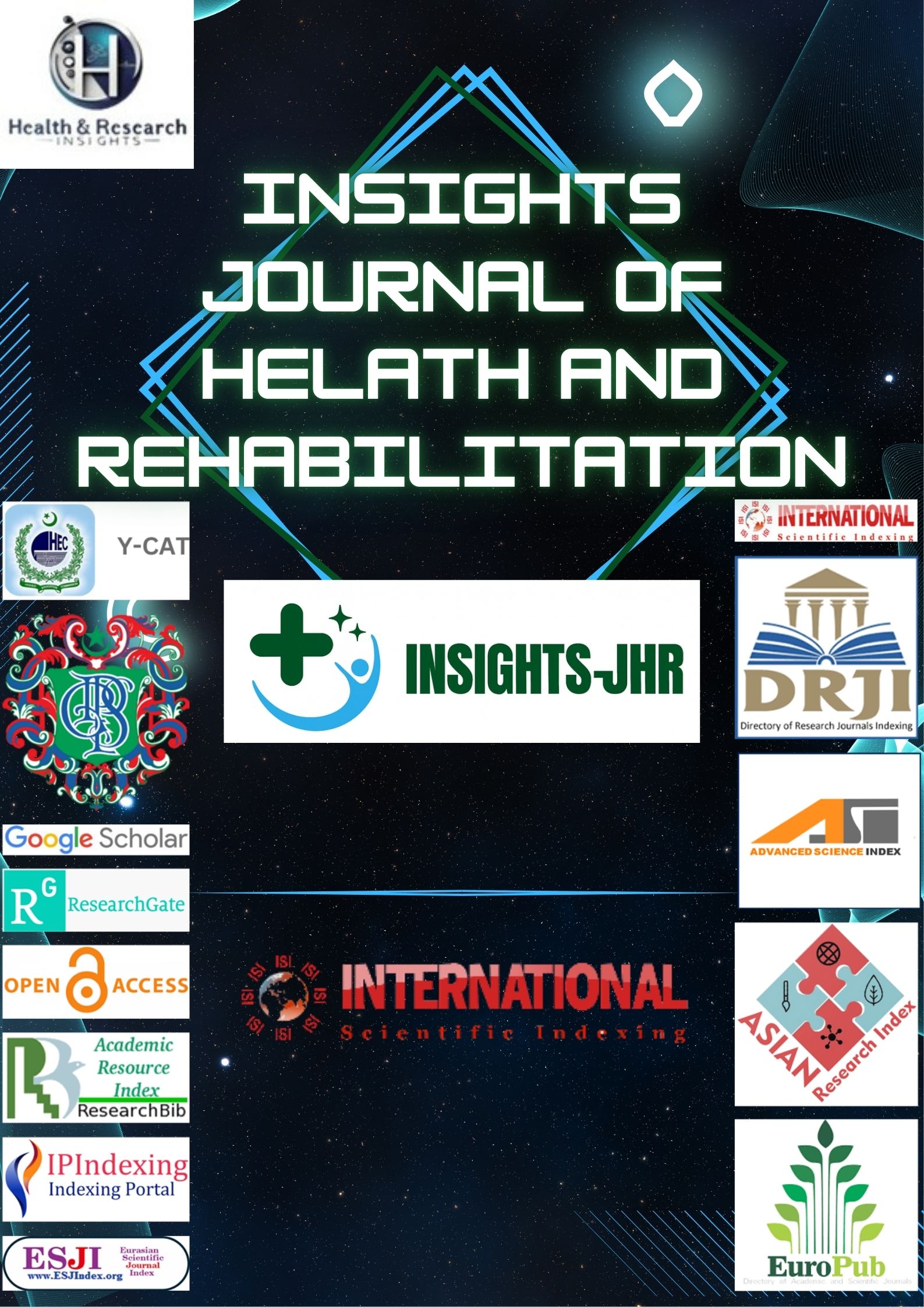FREQUENCY OF IRON DEFICIENCY ANEMIA IN ADULTS AND ITS ASSOCIATION WITH RED BLOOD CELL INDICES AND VARIOUS RISK FACTORS AT MARDAN MEDICAL COMPLEX
DOI:
https://doi.org/10.71000/86t7q816Keywords:
Iron deficiency anemia, , adults, red blood cell indices, risk factors, MCV, dietary intake, MardanAbstract
Background: Iron deficiency anemia (IDA) remains a major public health problem, particularly in developing countries, and is associated with adverse health and socioeconomic outcomes. Identifying its frequency and associated risk factors is crucial for improving prevention and management strategies.
Objective: To determine the frequency of iron deficiency anemia in adults attending Mardan Medical Complex and to examine its association with red blood cell (RBC) indices and various demographic and dietary risk factors.
Methods: A cross-sectional study was conducted on 207 adult patients. Data on demographics, body mass index (BMI), dietary intake patterns, and medical history were collected using structured questionnaires. Laboratory investigations included complete blood count and mean corpuscular volume (MCV) classification. Data were analyzed using descriptive statistics, chi-square tests, and logistic regression to identify significant predictors of IDA.
Results: The overall frequency of IDA was 47.3% (n = 98). Females had a significantly higher prevalence than males (55.0% vs 36.8%, p = 0.008). IDA was strongly associated with underweight BMI (77.8%, p = 0.006) and microcytic MCV (<80 fL) (70.6%, p < 0.001). Dietary risk factors included low red meat intake (61.3% in IDA group), frequent tea/coffee consumption with meals (67.3%), and low vitamin C intake (44.9%). Logistic regression analysis showed that female sex (AOR = 2.10, p = 0.009), underweight BMI (AOR = 3.25, p = 0.041), low red meat intake (AOR = 2.85, p = 0.001), and microcytic MCV (AOR = 5.85, p < 0.001) were independent predictors of IDA, while iron supplementation was protective (AOR = 0.48, p = 0.038).
Conclusion: Iron deficiency anemia is highly prevalent among adults in Mardan, particularly in women, underweight individuals, and those with poor dietary habits. Routine screening, nutritional education, and promotion of iron-rich diets and supplementation are recommended to reduce the burden of IDA.
References
Miller JL. Iron deficiency anemia: A common and curable disease. Cold Spring Harb Perspect Med. 2013;3:a011866. doi:10.1101/cshperspect.a011866
Vibhute NA, Shah U, Belgaumi U, Kadashetti V, Bommanavar S, Kamate W. Prevalence and awareness of nutritional anemia among female medical students in Karad, Maharashtra, India: A cross-sectional study. J Family Med Prim Care. 2019;8(7):2369–72. doi:10.4103/jfmpc.jfmpc_353_19
GBD Collaborators. Prevalence, years lived with disability, and trends in anaemia burden by severity and cause, 1990–2021: Findings from the Global Burden of Disease Study 2021. Lancet Haematol. 2023;10(9):e713–34. doi:10.1016/S2352-3026(23)00160-6
World Health Organization. Prevalence of anemia among women of reproductive age (% of women ages 15–49) – Iran, Islamic Rep. World Bank Group; 2019.
Kassebaum NJ. The global burden of anemia. Hematol Oncol Clin North Am. 2016;30(2):247–60. doi:10.1016/j.hoc.2015.11.002
World Health Organization. Nutritional anaemias: Report of a WHO scientific group [meeting held in Geneva from 13 to 17 March 1967]. Geneva: WHO; 1968.
Saydam BK, Genc RE, Sarac F, Turfan EC. Prevalence of anemia and related factors among women in Turkey. Pak J Med Sci. 2017;33(2):433–8. doi:10.12669/pjms.332.11771
World Health Organization. WHO global anaemia estimates, 2021 edition: Global anaemia estimates in women of reproductive age, by pregnancy status, and in children aged 6–59 months. Geneva: WHO; 2021.
Alvarez-Uria G, Naik PK, Midde M, Yalla PS, Pakam RJA. Prevalence and severity of anaemia stratified by age and gender in rural India. Anemia. 2014;2014:176182. doi:10.1155/2014/176182
Soppi ET. Iron deficiency without anemia: A clinical challenge. Clin Case Rep. 2018;6(6):1082–6. doi:10.1002/ccr3.1529
Scholz BD, Gross R, Schultink W, Sastroamidjojo S. Anaemia is associated with reduced productivity of women workers even in less-physically-strenuous tasks. Br J Nutr. 1997;77(1):47–57. doi:10.1017/s0007114500002877
Deal JA, Carlson MC, Xue QL, Fried LP, Chaves PH. Anemia and 9-year domain-specific cognitive decline in community-dwelling older women: The women’s health and aging study II. J Am Geriatr Soc. 2009;57(9):1604–11. doi:10.1111/j.1532-5415.2009.02400.x
Perez EM, Hendricks MK, Beard JL, Murray-Kolb LE, Berg A, Tomlinson M, et al. Mother–infant interactions and infant development are altered by maternal iron deficiency anemia. J Nutr. 2005;135(4):850–5. doi:10.1093/jn/135.4.850
Kassebaum NJ, Jasrasaria R, Naghavi M, Wulf SK, Johns N, Lozano R, et al. A systematic analysis of global anemia burden from 1990 to 2010. Blood. 2014;123(5):615–24. doi:10.1182/blood-2013-06-508325
Tijerina-Sáenz A, Martínez-Garza NE, Ramírez-López E, Solís-Pérez E, Martínez-Báez AZ. Iron status and dietary intakes of iron in normal-weight and obese young Mexican women. Nutr Hosp. 2015;31(6):2412–8. doi:10.3305/nh.2015.31.6.8687
Bathla S, Arora S. Prevalence and approaches to manage iron deficiency anemia (IDA). Crit Rev Food Sci Nutr. 2022;62(37):8815–28. doi:10.1080/10408398.2021.1935442
Wolmarans P, Dhansay MA, Mansvelt EP, Laubscher JA, Benadé AJ. Iron status of South African women working in a fruit-packing factory. Public Health Nutr. 2003;6(5):439–45. doi:10.1079/PHN2003460
Shah SA, Soomro U, Ali O, Tariq Y, Waleed MS, Guntipalli P, et al. The prevalence of anemia in working women. Cureus. 2023;15(6):e44104. doi:10.7759/cureus.44104
Bruinvels G, Burden R, Brown N, Richards T, Pedlar C. The prevalence and impact of heavy menstrual bleeding (menorrhagia) in elite and non-elite athletes. PLoS One. 2016;11(2):e0149881. doi:10.1371/journal.pone.0149881
Mishra AS, Lakhera PC, Pandey A. Assessment of nutritional anemia on the basis of dietary pattern estimation among the population of Garhwal Himalayan region. J Family Med Prim Care. 2021;10(2):669–74. doi:10.4103/jfmpc.jfmpc_1395_20
Egbi G, Gbogbo S, Mensah GE, Glover-Amengor M, Steiner-Asiedu M. Effect of green leafy vegetables powder on anaemia and vitamin A status of Ghanaian school children. BMC Nutr. 2018;4:14. doi:10.1186/s40795-018-0235-x
Stuetz W, Gowele V, Kinabo J, Bundala N, Mbwana H, Rybak C, et al. Consumption of dark green leafy vegetables predicts vitamin A and iron intake and status among female small-scale farmers in Tanzania. Nutrients. 2019;11(5):1025. doi:10.3390/nu11051025
Institute of Medicine (US) Panel on Micronutrients. Dietary reference intakes for vitamin A, vitamin K, arsenic, boron, chromium, copper, iodine, iron, manganese, molybdenum, nickel, silicon, vanadium, and zinc. Washington (DC): National Academies Press; 2001.
Downloads
Published
Issue
Section
License
Copyright (c) 2025 Muhammad Sufyan, Kamil Raza, Umair Khan, Sahibzada Umair Ahmad, Ehsan Safdar, Muhammad Owais, Waseem Iqbal, Saddam Hussain (Author)

This work is licensed under a Creative Commons Attribution-NonCommercial-NoDerivatives 4.0 International License.







